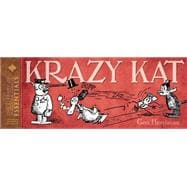Much attention has been paid to Herrriman’s Sunday full-page comics, yet it is in the daily Krazy Kat strips that the cartoonist most frankly illustrates many of his major themes, especially the shifting nature of social identity.
The 1934 strips reprinted in this book fit anyone’s definition of "essential." They show Krazy Kat at top speed, ever-changing, endlessly inventive, with language that sparkles with double meanings, and more, in lines such as "his malady drills me to my sole."
The year includes homages to old jokes and bricks, followed by playful references to sex, drink, and even drugs. The daily Krazy Kat strips are often Herriman’s most personal works and standouts in this year include Krazy Kat’s attempt to write a memoir and the Kat’s quietly waiting for the last leaf of "ottim" to fall (a tender scene that finds echoes in Charles Schulz’s drawing Linus admiring the last autum’s leaf stubborn spirit). It could also be argued that the daily is more accessible to the new reader. Herriman biographer Michael Tisserand provides an insightful introduction.
LOAC Essentials reprints, one year at a time, the daily newspaper strips that are essential to comics history, in a format that preserves, as closely as possible, the original reader experience. By reproducing the strips one per page in an oblong format, it allows us to have the experience of reading the comics one day at a time. Each volume contains seminal strips that are unique creations in their right and also contributed to the advancement of the medium, along with panel-by-panel annotations.








